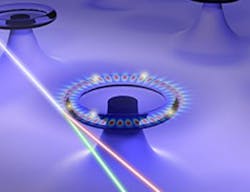A team of researchers at Washington University in St. Louis (St. Louis, MO), led by Lan Yang, the Das Family Career Development Associate Professor in Electrical & Systems Engineering, and collaborators at Tsinghua University (Beijing, China) have developed a new sensor that can detect and count nanoparticles, at sizes as small as 10 nm, one at a time.1 The researchers say the sensor could potentially detect much smaller particles, viruses, and small molecules.
In 2011, the Washington University in St. Louis researchers described a similar device, except that it required doping with erbium. The new device requires no doping.
The device is an array of self-referenced and self-heterodyned whispering-gallery Raman microlasers created in an undoped silicon dioxide chip. A pump laser generates a single Raman lasing mode inside the silica resonators. Upon landing of a nanoparticle on the resonator, Raman laser light circulating inside the resonator undergoes mode splitting, leading to two new lasing modes in different colors. Monitoring the changes in the color difference (frequency difference) enables detecting and measuring of nanoparticles with single-particle resolution.
"[The undoped Raman-laser approach] gives us the advantage of using the same dopant-free sensor at different sensing environments by tailoring the lasing frequency for the specific environment, for example, at the band where the environment has minimum absorption, and for the properties of the targeted nanoparticles by just changing the wavelength of the pump laser," says Sahin Kaya Ozdemir, a research scientist in Yang's group and the first author of the paper.
The technology should benefit the electronics, acoustics, biomedical, plasmonics, security, and metamaterials fields.
In addition to the demonstration of Raman microlasers for particle sensing, the team says their work shows the possibility of using intrinsic gain mechanisms, such as Raman and parametric gain, instead of optical dyes, rare-earth ions, or quantum dots for loss compensation in optical and plasmonic systems where dissipation hinders progress and limits applications.
Source: http://news.wustl.edu/news/Pages/27295.aspx
REFERENCE:
Ozdemir S. et al., Proceedings of the National Academy of Sciences, online Early Edition, Sept. 1, 2014; doi: 10.1073/pnas.1408283111

